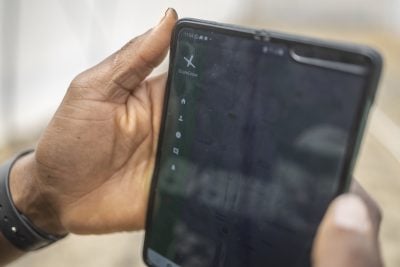With the arrival of Covid-19 in sub-Saharan Africa, debt-ridden nations braced for a surge in infections that would overburden vulnerable health systems. Despite the loud predictions of doomsayers, the continent has so far proved resilient, experiencing a limited swell of cases and a relatively low death rate, according to official figures. The virus has, nevertheless, left its stamp on the region and its economies.
As Africa locked down, national and local economies were upended. Businesses and schools closed, investors retreated and food insecurity increased. Hospitality, tourism and the financial industry were hardest hit. Last year the IMF expected sub-Saharan Africa’s overall GDP to grow by 3.2% in 2020, but it now predicts a contraction of 3%.
Yet one sector, telecommunications, has grown stronger during the pandemic, thanks to a powerful surge in demand as hundreds of millions of Africans reached for their phones. They have not let go since.
“Without mobile telecommunications networks, Africa would have ground to a halt,” says Akinwale Goodluck, head of industry consultancy GSMA in Sub-Saharan Africa. As the continent shifted online, data networks that have experienced transformational investment in recent years witnessed huge upsurges in traffic as sectors including education and entertainment headed online and employees worked from home.
At first, Covid-19 sparked industry concern… But the mild hit was more than offset by an unprecedented surge in data usage.
Eight months into the pandemic, telcos stand on the brink of a historic opportunity. From a push into banking to transformational infrastructure investments, Covid-19 could be a rocket booster for a sector which has already gained a reputation as a 21st century African success story.
Telecoms growth was solid before the pandemic. Operators successfully pushed into cities across the continent, but comprehensive coverage has been extended more gradually for rural communities.
On a continent of some 1.3bn, around 477m Africans are unique mobile subscribers today, 272m of whom have access to mobile internet, according to a recent report by GSMA. The mobile industry directly and indirectly contributes about 9% of sub-Saharan Africa’s GDP, says Goodluck, directly supporting 650,000 jobs.
At first, Covid-19 sparked industry concern. The swing from traditionally lucrative calls and texts to free messaging apps such as WhatsApp accelerated. With government-enforced data price caps mulled in major markets and consumer wallets lighter, telcos reduced their prices.
But the mild hit was more than offset by an unprecedented surge in data usage. Mobile data traffic in South Africa increased by half almost overnight, while reliance on services such as mobile money also increased.
On 15 May, The Guardian of Nigeria quoted Goodluck as saying there had been a 20% increase in data and voice revenues in Nigeria and other African countries in the previous two months.
With so many potential customers still unconnected, operators now intend to push towards universal coverage, boost 4G, and diversify revenues by introducing new services. The key challenge is how to invest in network capacity upgrades amid a tough economic climate, while consumers and governments plead with them to cut prices.
Covid-19 accelerates mobile money takeoff
One area ripe for strong growth is mobile money, the spread of which has been accelerated by Covid-19, as businesses grow reticent to handle cash, bank branches close and governments digitise their economic support for citizens.
“The strategic opportunity for telcos is clear,” says François Jurd de Girancourt, head of the financial institutions practice at McKinsey Africa. “Telcos need to compensate for structural decline in average revenue per users; a customer with a mobile finance wallet has a significantly lower risk of churn; and mobile phone penetration in most African countries is close to 100% [based on SIM card numbers] when banking penetration is still between 30-50%.”
Declining remittances have hurt households and mobile money providers as global growth slows. According to the World Bank, remittances to sub-Saharan Africa will fall by 23.1% to $37bn this year.
Even so, African telecoms companies have made strong forays into banking and cashless payments since the onset of the pandemic. Big players Orange, MTN, Vodacom and Telkom, have all added new services, including loans, and slashed mobile money fees.
Orange launched its first full banking operation in Africa and MTN recorded a 28% jump in mobile money transactions across all African markets in the first two quarters of this year.
As companies push into mobile banking, the number of registered mobile money accounts in sub-Saharan Africa is expected to reach half a billion this year, says GSMA. The opportunity is clear.
“Our ambition is really by the end of 2021 to have 60m customers using mobile money on a daily basis,” up from 38m in June, says Sérigne Dioum, head of MTN’s mobile financial services division. “It is to help people to be able to save, to be more wealthy, to get access to loans, and to create a merchant ecosystem across the continent. Our long-term vision is to become the biggest financial service platform within Africa.”
Partnerships with traditional banks offer another source of potential revenue for telcos, and governments and central banks have a crucial role to play in implementing friendly regulations and digitising their own services.
“When [governments] give social disbursements, they can do it through mobile money. When you renew your driving licence or you pay your taxes, you can do it through mobile money,” says Dioum.
Connectivity is everything
While financial services are a key driver of future growth, traditional revenue streams will prove the primary driver of revenues for telcos, say analysts.
“Mobile money is important of course, but connectivity in a more general sense, the human need to stay in touch and keep up to date on news, is the big driver of telco development in Africa,” says François Conradie, economist at NKC African Economics.
An MTN spokesperson says that fintech accounts for approximately 7% of the company’s revenue, compared to 80% for voice and data. The key thrust of telco strategy today is therefore to grow mobile subscribers and increase smartphone penetration.
GSMA predicts that regional smartphone penetration will increase from 45% today to 65% by 2025. Kenya, South Africa and Nigeria are on track to be the region’s top three smartphone markets by 2025, while Tanzania and DRC, both of which have low penetration levels, are likely sources of future growth.
Ethiopia, with a population of more than 112m and a government that has expressed an intention to liberalise the state-owned telecoms market and award new licences to private operators, is a key target watched by all the continent’s major telcos.
“It is a demographics play, so densely populated countries, where infrastructure spend can connect the most people per mast erected with some disposable income, are the most attractive,” says Conradie.
Government action can help speed these processes. This year, Nigeria released a new broadband plan which aims to achieve 70% penetration by 2025.
4G is the immediate focus
Despite pervasive talk of Africa “leapfrogging” to the next stage of technological development, 3G and 4G are likely to be the primary focus of connectivity efforts for the foreseeable future.
“With significant unused 4G capacity and 4G adoption still relatively low, the focus in the near term for operators and other stakeholders is to increase 4G uptake. This will involve strategies to make 4G devices more affordable and the provision of relevant digital content to drive demand for enhanced connectivity services,” says the GSMA report. 5G will mostly be taken up by households, businesses and well-off mobile customers.
Before most countries can dream of 5G, there is still plenty of work to be done on basic connectivity, with hundreds of millions of Africans still lacking services.
“5G will be the Rolls Royce of services,” says Goodluck, who believes that Africa can learn from first adopters in sourcing cheaper equipment and identifying a compelling business case.
Some governments, however, are unwilling to wait. South Africa was one of the world’s first countries to grant temporary 5G spectrum earlier this year to address pandemic-related supply issues. MTN, Vodacom and Rain have all launched commercial 5G networks in the country. 5G trials have been conducted in Gabon, Kenya, Nigeria and Uganda. 5G investment, which accounts for just 9% this year, will account for 52% by 2025.
Still, by 2025, there will be just under 30m mobile 5G connections in sub-Saharan Africa, predicts GSMA, equivalent to just 3% of total mobile connections. By the same date, 3G is expected to account for 58% of connections and 4G is expected to account for 27%.
“The immediate opportunity for 5G in South Africa, as well as the rest of the region, is to use fixed wireless access to bridge the gap in fixed broadband connectivity for homes and businesses. However, mass adoption of mobile 5G is not imminent in the region.”
Before most countries can dream of 5G, there is still plenty of work to be done on basic connectivity, with hundreds of millions of Africans still lacking services, most of them in low-income rural areas, where network expansion is expensive. Governments, operators, advocacy groups and the AU are all examining ways to bridge the divide, including easing regulations and developing low-cost smartphones. Windfall taxes on rising telco revenues are reportedly being mooted by some governments, alarming some analysts.
Catalyst for the sector
Nevertheless, the Covid-19 pandemic has already been a catalyst for Africa’s telecoms sector, hastening the spread of mobile money, increasing demand for data and reaffirming the importance of digital communications.
Operators on the continent amassed $44.3bn in revenues in 2019, a number expected to rise to $48.7bn by 2025. They will invest $52bn in infrastructure rollouts between 2019 and 2025 as mobile data consumption in sub-Saharan Africa grows more than fourfold. The number of smartphone connections is expected to almost double to 678m by the end of 2025 as cheaper handsets hit the market.
“The industry has always had as one of its greatest priorities universal coverage, universal services, and the pandemic, I dare say, has really made this very, very important,” says Goodluck. “The indicators are good and bright for the mobile industry in sub-Saharan Africa.”
Read more from our special report on African telecoms.
Want to continue reading? Subscribe today.
You've read all your free articles for this month! Subscribe now to enjoy full access to our content.
Digital Monthly
£8.00 / month
Receive full unlimited access to our articles, opinions, podcasts and more.
Digital Yearly
£70.00 / year
Our best value offer - save £26 and gain access to all of our digital content for an entire year!
 Sign in with Google
Sign in with Google 



